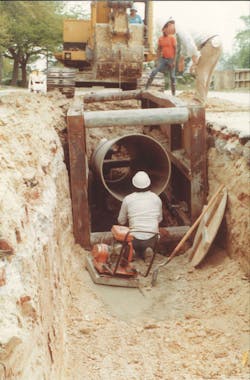In February of 2013, the city of Houston solicited bids for the Hendrick Force Main Crossing project, which included the demolition of an existing aerial force main, and construction of a new force main crossing under Buffalo Bayou. The force main includes more than 1,200 ft of pipe. Installation by directional drilling was used for 700 ft of 42-in. HDPE under the bayou, and 400 ft of 36-in. Hobas pipe was installed in the areas where open cut was an option.
The new force main transitioned to an existing line that included 36-in. diameter pipe, which is beyond the open cut portion of the project. To make the connection to the new 42-in. diameter section, Hobas supplied a flanged connection, which mated with the HDPE flanged connection.
Reytec Construction Resources Inc. of Houston, a general contractor founded in 1996, was awarded the project. The 36-in. pipe supplied by Hobas Pipe USA had a unique situation since it connected to the existing 36-in. diameter line that was a Hobas installation completed in 1988. What made the project unique was not the Hobas-to-Hobas connection, but rather the age of the existing pipe. The original 36-in. diameter Hobas line that Reytec was now connecting to was part of the Magnolia Street Force Main.
This force main was the very first force main sewer installation using Hobas pipe manufactured in the U.S. The Magnolia Street Force Main was a 7,000-ft line constructed to redistribute sewerage flows as part of the East Side WWTP Relief Program.
Versatile Fitting Manufacture
The original line, constructed 26 years ago, includes more than 20 elbows to follow the zigzag route through an existing residential neighborhood. “Until we dug it up, we didn’t exactly know what we were dealing with as far as the alignment and condition of the original line. We appreciated the responsiveness of Hobas to deliver the necessary custom pieces. We added several mitered fittings to the order to assist us with making the connection between the existing pipe and the new line,” said Tomas Garza, site supervisor, Reytec Construction Resources Inc. “The pipe material is rugged and user friendly and the couplings provide leak free connections.”
Corrosion Concerns
The design engineer for the original Magnolia Street Force Main was concerned about both internal and external corrosion of the line and also needed a high strength pipe with leak-free joints to withstand the 125-psi design pressure. Because of these requirements, only Hobas PN 150 SN 46 (minimum 150 psi pressure rating and 46-psi stiffness rating) and cement lined class 52 Ductile Iron with polybags were specified.
Quick Delivery
Hobas pipes were chosen for the Magnolia Street Force Main project by BRH Garver of Houston due to their competitive price and quick delivery. At the time of the installation, the superintendent for BRH Garver said, “The Hobas pipe is a rugged product and is easy to lay.” A quarter of a century later, the current installation contactor, Raytec, uncovered this pipe to take a look.
“When we uncovered the original Hobas pipe that had been buried and in service for over 25 years, it looked like it could have been buried yesterday, it was still in perfect condition,” said Garza.
Source: Hobas Pipe USA

